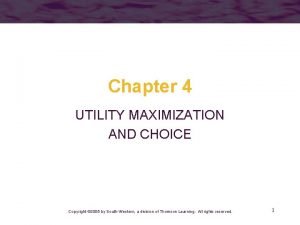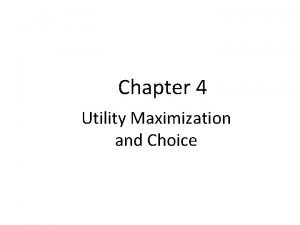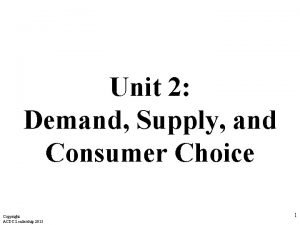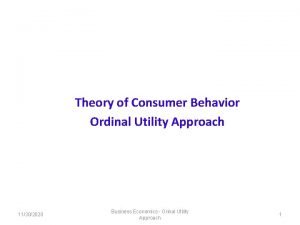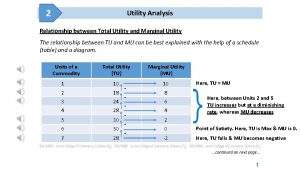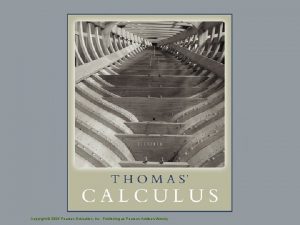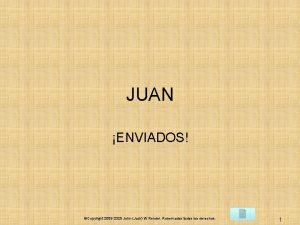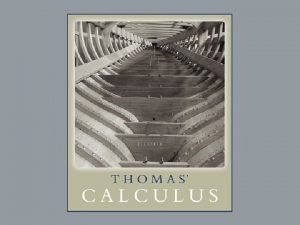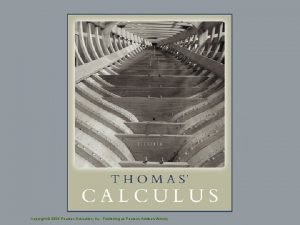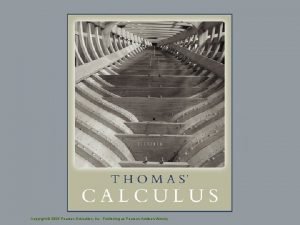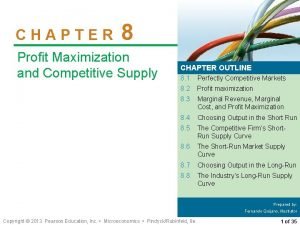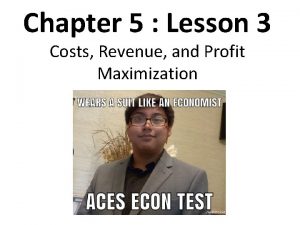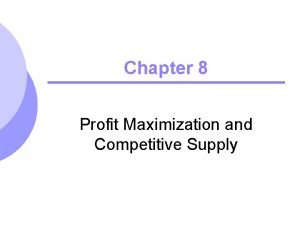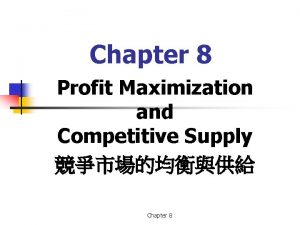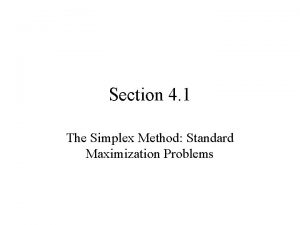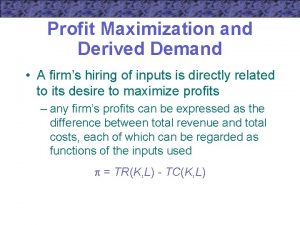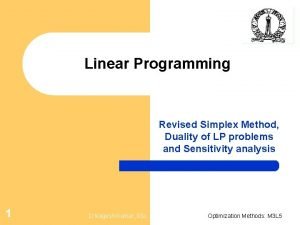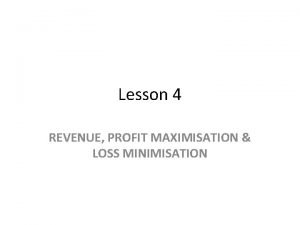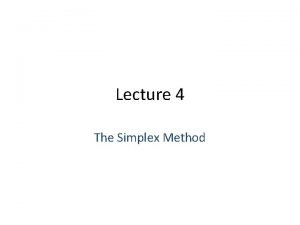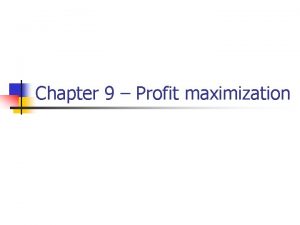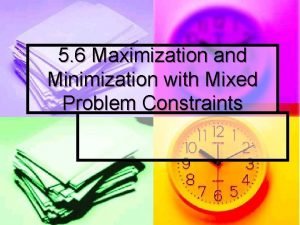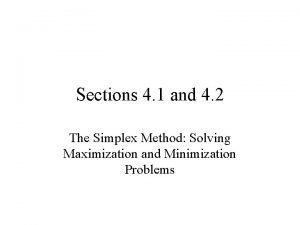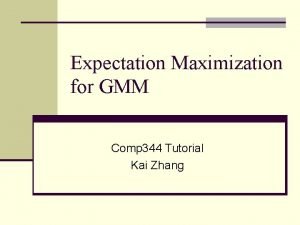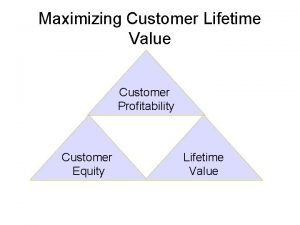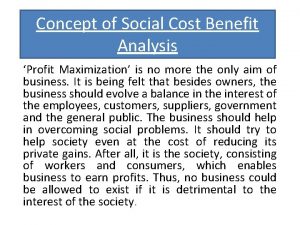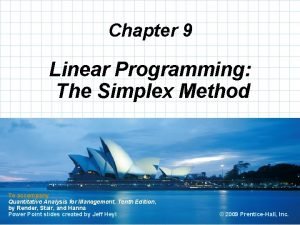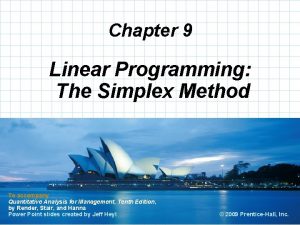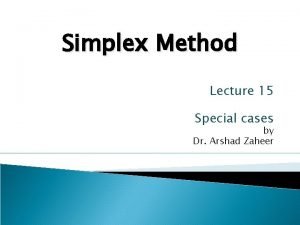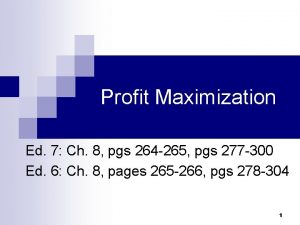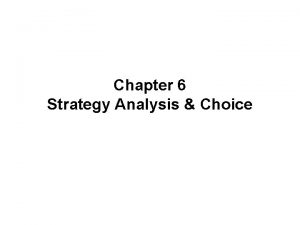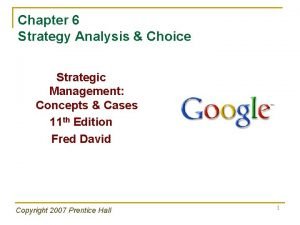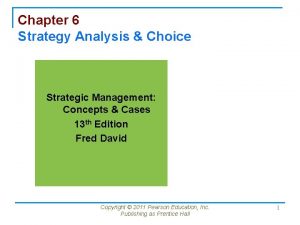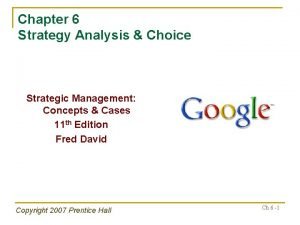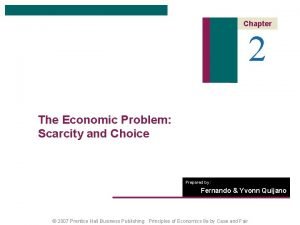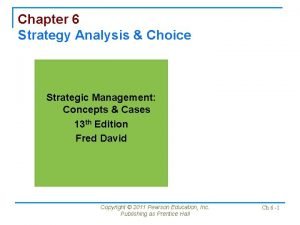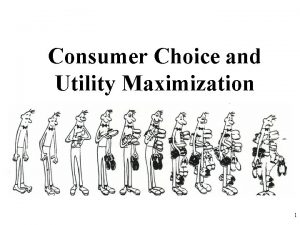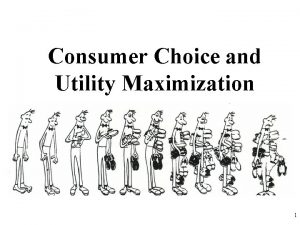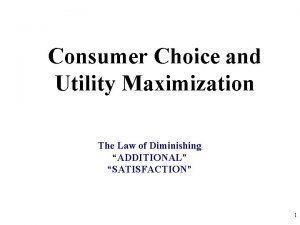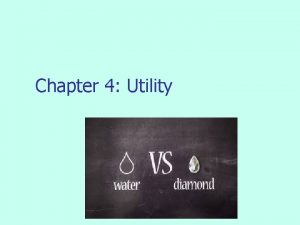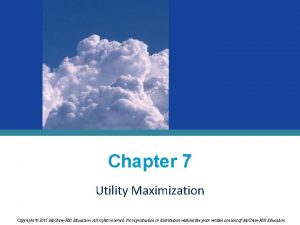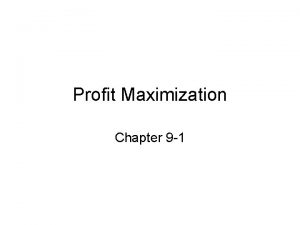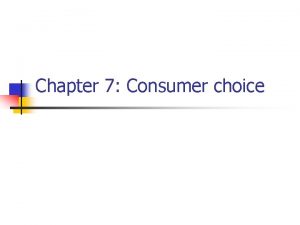Chapter 4 UTILITY MAXIMIZATION AND CHOICE Copyright 2005

















































- Slides: 49

Chapter 4 UTILITY MAXIMIZATION AND CHOICE Copyright © 2005 by South-Western, a division of Thomson Learning. All rights reserved. 1

Complaints about the Economic Approach • No real individuals make the kinds of “lightning calculations” required for utility maximization • The utility-maximization model predicts many aspects of behavior • Thus, economists assume that people behave as if they made such calculations 2

Complaints about the Economic Approach • The economic model of choice is extremely selfish because no one has solely self-centered goals • Nothing in the utility-maximization model prevents individuals from deriving satisfaction from “doing good” 3

Optimization Principle • To maximize utility, given a fixed amount of income to spend, an individual will buy the goods and services: – that exhaust his or her total income – for which the psychic rate of trade-off between any goods (the MRS) is equal to the rate at which goods can be traded for one another in the marketplace 4

A Numerical Illustration • Assume that the individual’s MRS = 1 – willing to trade one unit of x for one unit of y • Suppose the price of x = $2 and the price of y = $1 • The individual can be made better off – trade 1 unit of x for 2 units of y in the marketplace 5

The Budget Constraint • Assume that an individual has I dollars to allocate between good x and good y pxx + pyy I Quantity of y If all income is spent on y, this is the amount of y that can be purchased The individual can afford to choose only combinations of x and y in the shaded triangle If all income is spent on x, this is the amount of x that can be purchased Quantity of x 6

First-Order Conditions for a Maximum • We can add the individual’s utility map to show the utility-maximization process Quantity of y The individual can do better than point A by reallocating his budget A The individual cannot have point C because income is not large enough C B U 3 U 2 U 1 Point B is the point of utility maximization Quantity of x 7

First-Order Conditions for a Maximum • Utility is maximized where the indifference curve is tangent to the budget constraint Quantity of y B U 2 Quantity of x 8

Second-Order Conditions for a Maximum • The tangency rule is only necessary but not sufficient unless we assume that MRS is diminishing – if MRS is diminishing, then indifference curves are strictly convex • If MRS is not diminishing, then we must check second-order conditions to ensure that we are at a maximum 9

Second-Order Conditions for a Maximum • The tangency rule is only a necessary condition – we need MRS to be diminishing Quantity of y There is a tangency at point A, but the individual can reach a higher level of utility at point B B A U 2 U 1 Quantity of x 10

Corner Solutions • In some situations, individuals’ preferences may be such that they can maximize utility by choosing to consume only one of the goods Quantity of y U 1 U 2 At point A, the indifference curve is not tangent to the budget constraint U 3 Utility is maximized at point A A Quantity of x 11

The n-Good Case • The individual’s objective is to maximize utility = U(x 1, x 2, …, xn) subject to the budget constraint I = p 1 x 1 + p 2 x 2 +…+ pnxn • Set up the Lagrangian: L = U(x 1, x 2, …, xn) + (I - p 1 x 1 - p 2 x 2 -…- pnxn) 12

The n-Good Case • First-order conditions for an interior maximum: L/ x 1 = U/ x 1 - p 1 = 0 L/ x 2 = U/ x 2 - p 2 = 0 • • • L/ xn = U/ xn - pn = 0 L/ = I - p 1 x 1 - p 2 x 2 - … - pnxn = 0 13

Implications of First-Order Conditions • For any two goods, • This implies that at the optimal allocation of income 14

Interpreting the Lagrangian Multiplier • is the marginal utility of an extra dollar of consumption expenditure – the marginal utility of income 15

Interpreting the Lagrangian Multiplier • At the margin, the price of a good represents the consumer’s evaluation of the utility of the last unit consumed – how much the consumer is willing to pay for the last unit 16

Corner Solutions • When corner solutions are involved, the first-order conditions must be modified: L/ xi = U/ xi - pi 0 (i = 1, …, n) • If L/ xi = U/ xi - pi < 0, then xi = 0 • This means that – any good whose price exceeds its marginal value to the consumer will not be purchased 17

Cobb-Douglas Demand Functions • Cobb-Douglas utility function: U(x, y) = x y • Setting up the Lagrangian: L = x y + (I - pxx - pyy) • First-order conditions: L/ x = x -1 y - px = 0 L/ y = x y -1 - py = 0 L/ = I - pxx - pyy = 0 18

Cobb-Douglas Demand Functions • First-order conditions imply: y/ x = px/py • Since + = 1: pyy = ( / )pxx = [(1 - )/ ]pxx • Substituting into the budget constraint: I = pxx + [(1 - )/ ]pxx = (1/ )pxx 19

Cobb-Douglas Demand Functions • Solving for x yields • Solving for y yields • The individual will allocate percent of his income to good x and percent of his income to good y 20

Cobb-Douglas Demand Functions • The Cobb-Douglas utility function is limited in its ability to explain actual consumption behavior – the share of income devoted to particular goods often changes in response to changing economic conditions • A more general functional form might be more useful in explaining consumption decisions 21

CES Demand • Assume that = 0. 5 U(x, y) = x 0. 5 + y 0. 5 • Setting up the Lagrangian: L = x 0. 5 + y 0. 5 + (I - pxx - pyy) • First-order conditions: L/ x = 0. 5 x -0. 5 - px = 0 L/ y = 0. 5 y -0. 5 - py = 0 L/ = I - pxx - pyy = 0 22

CES Demand • This means that (y/x)0. 5 = px/py • Substituting into the budget constraint, we can solve for the demand functions 23

CES Demand • In these demand functions, the share of income spent on either x or y is not a constant – depends on the ratio of the two prices • The higher is the relative price of x (or y), the smaller will be the share of income spent on x (or y) 24

CES Demand • If = -1, U(x, y) = -x -1 - y -1 • First-order conditions imply that y/x = (px/py)0. 5 • The demand functions are 25

CES Demand • If = - , U(x, y) = Min(x, 4 y) • The person will choose only combinations for which x = 4 y • This means that I = pxx + pyy = pxx + py(x/4) I = (px + 0. 25 py)x 26

CES Demand • Hence, the demand functions are 27

Indirect Utility Function • It is often possible to manipulate firstorder conditions to solve for optimal values of x 1, x 2, …, xn • These optimal values will depend on the prices of all goods and income x*1 = x 1(p 1, p 2, …, pn, I) x*2 = x 2(p 1, p 2, …, pn, I) • • • x*n = xn(p 1, p 2, …, pn, I) 28

Indirect Utility Function • We can use the optimal values of the xs to find the indirect utility function maximum utility = U(x*1, x*2, …, x*n) • Substituting for each x*i, we get maximum utility = V(p 1, p 2, …, pn, I) • The optimal level of utility will depend indirectly on prices and income – if either prices or income were to change, the maximum possible utility will change 29

The Lump Sum Principle • Taxes on an individual’s general purchasing power are superior to taxes on a specific good – an income tax allows the individual to decide freely how to allocate remaining income – a tax on a specific good will reduce an individual’s purchasing power and distort his choices 30

The Lump Sum Principle • A tax on good x would shift the utilitymaximizing choice from point A to point B Quantity of y B A U 1 U 2 Quantity of x 31

The Lump Sum Principle • An income tax that collected the same amount would shift the budget constraint to I’ Quantity of y Utility is maximized now at point C on U 3 I’ A B C U 3 U 1 U 2 Quantity of x 32

Indirect Utility and the Lump Sum Principle • If the utility function is Cobb-Douglas with = = 0. 5, we know that • So the indirect utility function is 33

Indirect Utility and the Lump Sum Principle • If a tax of $1 was imposed on good x – the individual will purchase x*=2 – indirect utility will fall from 2 to 1. 41 • An equal-revenue tax will reduce income to $6 – indirect utility will fall from 2 to 1. 5 34

Indirect Utility and the Lump Sum Principle • If the utility function is fixed proportions with U = Min(x, 4 y), we know that • So the indirect utility function is 35

Indirect Utility and the Lump Sum Principle • If a tax of $1 was imposed on good x – indirect utility will fall from 4 to 8/3 • An equal-revenue tax will reduce income to $16/3 – indirect utility will fall from 4 to 8/3 • Since preferences are rigid, the tax on x does not distort choices 36

Expenditure Minimization • Dual minimization problem for utility maximization – allocating income in such a way as to achieve a given level of utility with the minimal expenditure – this means that the goal and the constraint have been reversed 37

Expenditure Minimization • Point A is the solution to the dual problem Quantity of y Expenditure level E 2 provides just enough to reach U 1 Expenditure level E 3 will allow the individual to reach U 1 but is not the minimal expenditure required to do so A Expenditure level E 1 is too small to achieve U 1 Quantity of x 38

Expenditure Minimization • The individual’s problem is to choose x 1, x 2, …, xn to minimize total expenditures = E = p 1 x 1 + p 2 x 2 +…+ pnxn subject to the constraint utility = U 1 = U(x 1, x 2, …, xn) • The optimal amounts of x 1, x 2, …, xn will depend on the prices of the goods and the required utility level 39

Expenditure Function • The expenditure function shows the minimal expenditures necessary to achieve a given utility level for a particular set of prices minimal expenditures = E(p 1, p 2, …, pn, U) • The expenditure function and the indirect utility function are inversely related – both depend on market prices but involve different constraints 40

Two Expenditure Functions • The indirect utility function in the two-good, Cobb-Douglas case is • If we interchange the role of utility and income (expenditure), we will have the expenditure function E(px, py, U) = 2 px 0. 5 py 0. 5 U 41

Two Expenditure Functions • For the fixed-proportions case, the indirect utility function is • If we again switch the role of utility and expenditures, we will have the expenditure function E(px, py, U) = (px + 0. 25 py)U 42

Properties of Expenditure Functions • Homogeneity – a doubling of all prices will precisely double the value of required expenditures • homogeneous of degree one • Nondecreasing in prices – E/ pi 0 for every good, i • Concave in prices 43

Concavity of Expenditure Function At p*1, the person spends E(p*1, …) E(p 1, …) If he continues to buy the same set of goods as p*1 changes, his expenditure function would be Epseudo E(p 1, …) E(p*1, …) Since his consumption pattern will likely change, actual expenditures will be less than Epseudo such as E(p 1, …) p*1 p 1 44

Important Points to Note: • To reach a constrained maximum, an individual should: – spend all available income – choose a commodity bundle such that the MRS between any two goods is equal to the ratio of the goods’ prices • the individual will equate the ratios of the marginal utility to price for every good that is actually consumed 45

Important Points to Note: • Tangency conditions are only firstorder conditions – the individual’s indifference map must exhibit diminishing MRS – the utility function must be strictly quasiconcave 46

Important Points to Note: • Tangency conditions must also be modified to allow for corner solutions – the ratio of marginal utility to price will be below the common marginal benefitmarginal cost ratio for goods actually bought 47

Important Points to Note: • The individual’s optimal choices implicitly depend on the parameters of his budget constraint – choices observed will be implicit functions of prices and income – utility will also be an indirect function of prices and income 48

Important Points to Note: • The dual problem to the constrained utility-maximization problem is to minimize the expenditure required to reach a given utility target – yields the same optimal solution as the primary problem – leads to expenditure functions in which spending is a function of the utility target and prices 49
 Marshallian demand function
Marshallian demand function Perfect substitutes utility function
Perfect substitutes utility function Utility maximization
Utility maximization Ordinal utility
Ordinal utility Relation between marginal utility and total utility
Relation between marginal utility and total utility Pearson education inc publishing
Pearson education inc publishing Copyright 2005
Copyright 2005 2005 pearson prentice hall inc
2005 pearson prentice hall inc Copyright 2005
Copyright 2005 Copyright 2005
Copyright 2005 Copyright 2005
Copyright 2005 Copyright 2005
Copyright 2005 Copyright 2005
Copyright 2005 Copyright 2005
Copyright 2005 Copyright 2005
Copyright 2005 Good choice or bad choice
Good choice or bad choice Profit maximization and competitive supply
Profit maximization and competitive supply Lesson 3 cost revenue and profit maximization
Lesson 3 cost revenue and profit maximization Profit maximization and competitive supply
Profit maximization and competitive supply Profit maximization and competitive supply
Profit maximization and competitive supply Standard maximization problem
Standard maximization problem Monopsony profit maximization
Monopsony profit maximization Limitations of profit maximization
Limitations of profit maximization Dual simplex method maximization example
Dual simplex method maximization example Profit maximization
Profit maximization Simplex method problem
Simplex method problem Profit maximization
Profit maximization Big m method maximization example
Big m method maximization example Revised simplex calculator
Revised simplex calculator Module 53 featured worksheet profit maximization
Module 53 featured worksheet profit maximization Profit maximization in financial management
Profit maximization in financial management Expectation maximization tutorial
Expectation maximization tutorial Maximizing customer lifetime value
Maximizing customer lifetime value Objective of financial management
Objective of financial management Objectives of social cost benefit analysis
Objectives of social cost benefit analysis The zj row in a simplex table for maximization represents
The zj row in a simplex table for maximization represents What cj-zj represents
What cj-zj represents Expectation maximization algorithm
Expectation maximization algorithm Alternative optima
Alternative optima Social cost of monopoly
Social cost of monopoly Profit maximization
Profit maximization Chapter 56 oral and maxillofacial surgery
Chapter 56 oral and maxillofacial surgery Chapter 37 vital signs and measurements
Chapter 37 vital signs and measurements Chapter 6 strategy analysis and choice
Chapter 6 strategy analysis and choice Chapter 6 strategy analysis and choice
Chapter 6 strategy analysis and choice Chapter 6 strategy analysis and choice
Chapter 6 strategy analysis and choice Strategic management chapter 6
Strategic management chapter 6 The economic problem of scarcity
The economic problem of scarcity Strategy formulation analytical framework
Strategy formulation analytical framework Chapter 5 elasticity and its application multiple choice
Chapter 5 elasticity and its application multiple choice
